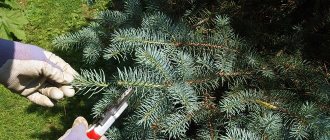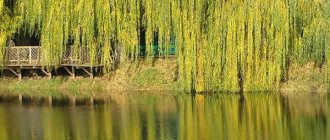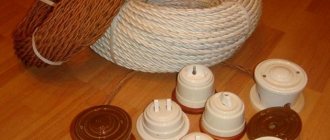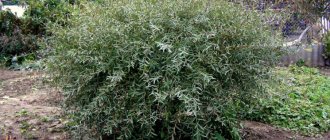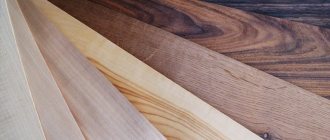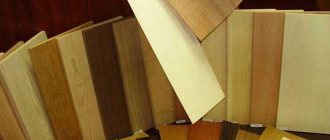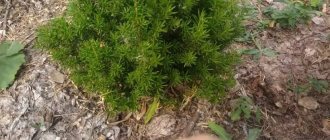Red oak was brought to Russia towards the end of the 19th century. You may not notice it in spring or summer, but in autumn it shimmers with shades of amazing beauty, which is why it got its name. The wood of this species is valuable, has a noble structure and a rich red-brown color. In Latin its name is quercus rubra, in Russia it is usually called holly, Canadian or northern.
How to choose planting material
Growing red oak on your own property is easy. To do this, just plant an acorn. The period for emergence of seedlings is from 2 to 3 weeks from the moment of planting. Agree that this method of growing requires a lot of time and effort.
You can purchase a ready-made seedling at a specialized nursery. Before making a purchase, there are several criteria to consider:
Planting material must have a closed root system. The presence of bare roots indicates that the plants may not take root in the new location.
During the formation of young oak roots, many myceliums appear in the soil, which actively interact with the ornamental plant.
When the earthen clod is destroyed, the tree in most cases does not survive the replanting process.
The leaf blades should reach 3 cm in length. They must have a uniform surface and without any defects.
The presence of bright spots on the leaves indicates a serious disease that can be transmitted to other ornamental crops. It is not recommended to purchase such planting material.
The thickness of the seedling trunk must be at least 1 cm.
Reproduction
The first method is acorns. They need to be collected in advance during the fruiting period (early and mid-autumn). First, a small root will appear from the seed, which is directed downward. A green stem with three leaves is formed. Young trees are pinched so that the side branches grow faster. How to grow a red oak tree from an acorn:
- Leave the seeds in warm water for 24 hours. Add growth stimulants. Before planting, soak the seeds in potassium permanganate for 30 minutes.
- Prepare the soil. Ideally, it should be 70% peat and 30% river sand. Poor and hydrated.
- Plant the seeds vertically in the ground, sprinkle with 2 cm of substrate.
- Cover with film and place them in a cold space for 2 months. The temperature there should not be higher than 2 degrees and lower than 5; the bottom shelf of the refrigerator is often used for these purposes.
- Germinate the acorns under the film, do not change the temperature. There should be enough moisture.
- After the young shoots hatch, they continue to be grown at room temperature.
Rubra is unpretentious. It is also replanted using root shoots. It is better to do this transplant in the summer so that the tree has time to take root before the first frost. Dead branches are cut off from a mature red oak tree. In winter, the young plant must be covered with film or other protective material.
Planting process
Red oak planting takes place in several stages. They include:
Preliminary preparation of the planting pit. The depth should be 30 cm and the width 50 cm.
A drainage layer must be laid at the bottom. To do this, use small pebbles or expanded clay. The thickness of the embankment does not exceed 2 cm.
Next, the planting material is removed from the container. After this, install it on the drainage layer.
The roots are sprinkled with a nutritious earthen substrate. We prepare it with a ratio of proportions of 1/3. The main part of the mixture consists of humus and peat, and the other part of a small amount of limestone.
The distance between seedlings should be 6 m. This will be enough to form a lush crown.
After planting, regular watering is carried out. It will allow the root system to adapt to the new location.
Description
Canadian red oak grows up to 25 meters in height. The crown looks like a tent, the branches are spreading, the scope expands closer to the base. All name options are associated with the specific shape and color of the leaf. The red plant attracts the eye, especially in autumn, and stands out as a bright spot among its yellow-leaved counterparts.
Botanical characteristics
Trunk diameter 18-30 cm Life expectancy There are representatives of the northern oak that reached 2000 years. On average, they live 300-400 years. It reaches its maximum height by the age of 150, and grows in width throughout its entire life. Bark, trunk Young trees: thin light gray bark, small trunk up to 40 cm in diameter. Adults: cracked dark gray bark, wide trunk. Flowers Flowering begins in late spring and lasts about a week. Flowers appear simultaneously with young leaves. The fruits of Acorns have a roundish shape, a maximum size of 2 cm, a rounded nose, they first appear in the fall in the second year after planting, and bear fruit steadily from 15-20 years. The leaves have deep grooves, pointed lobes on all sides, a narrow shape, shiny, up to 20 cm long. When the holly oak blossoms, they have a slightly red tint, in the summer they are green, in the fall the young seedlings have a scarlet-red color, and the old ones are brown -brown.
The root is developed, goes up to 20 meters into the ground. Soil requirements Undemanding. Tolerates highly acidic soil. Does not like calcareous and too saturated soils. Thermal stability Tolerates cold and does not react to heat. Growth rate Young oaks grow slowly, gaining speed with age. Quercus rubra haaren is tolerant of sunlight. Prefers full apical lighting. It is recommended to plant it in places where there is shade.
Spreading
Red oaks are native to North America. It grows on the banks of reservoirs, where there is no abundantly moist soil. Considered a typical Canadian plant. Came to Europe in the 17th century. Grows in England, France and Germany. In Russia, it is widespread in northern latitudes and is represented in the Botanical Garden of St. Petersburg. Tolerates frosts well. Specimens of the tree grow in the forests of the Moscow and Oryol regions, Yekaterinburg and the North Caucasus. Grown in parks in Estonia, Belarus and Ukraine.
Growing Red Oak from Acorns
How to grow an ornamental oak tree from an acorn? To do this you need to prepare:
A small container with many drain holes. They will help remove excess moisture from the pot and prevent the process of rotting.
Earthen substrate. It is prepared according to the same principle as filler for planting seedlings.
We place several elements of expanded clay at the bottom of the pot. It will act as drainage.
Place some soil on one container and place a Canadian oak acorn. We compact the earth mass together with planting material.
After this, water the container with settled water. We remove the workpiece to the south window. As the earthen clod dries out, it is necessary to carry out spraying and watering.
Meaning and Application
In ancient times, it was believed that the red oak was the most important tree. He was displayed in almost all city squares, and believers worshiped him during rituals. It was believed that any part of this tree has healing powers. It was strictly forbidden to cut it down, as this could cause the wrath of the gods.
Later, oak began to be used in a variety of industries: agriculture, the weapons industry, for the preparation of medicines and food. It was used to create ink for manuscripts. The wood is used to make materials for decoration and furniture, and is also used in applied arts. It is highly valued and is resistant to wear and tear. The wood is highly dense and hard, making it very difficult to process but easy to polish. If you properly care for red oak products, they will last a very long time (more than 100 years). When the tree is first cut down, the wood has a light color, but over the years it becomes more saturated and dark. High-strength wood is not afraid of sudden temperature changes.
The wood is used in the leather industry, shipbuilding and construction, and is also used for the manufacture of doors, barrels, veneers and parquet.
Benefits of red oak:
- A decoction is prepared from the leaves, used for diseases of the gastrointestinal tract and lungs, and it is also taken for colds.
- The wood is used to make incense sticks. They do not distort the smell, but rather improve it.
- An infusion of leaves and bark increases the body's immune defense and also helps with headaches.
Oak infusion is used for:
- colitis and colic;
- hemorrhoids;
- varicose veins;
- heart failure and liver diseases;
- diseases of the gastrointestinal tract;
- peptic ulcer disease;
- fluid incontinence in the body;
- bleeding gums.
Bees are attracted to flowering oak trees and use the pollen to make honey. The leaves are used as a dye for fabrics. Brooms are knitted from branches for baths. Wild animals love to feast on acorns, and they are also used to make flour.
How to care?
The care process involves meeting several requirements. These include:
Regular watering. From the moment of planting it is necessary to moisten the soil. An adult seedling is able to independently cope with moisture deficiency.
It is also necessary to loosen and remove weeds.
Mulching with dry grass or sawdust will prevent regular drying out of the soil.
In spring it is necessary to remove dry branches. This manipulation will allow the tree to quickly recover after the winter period.
Feeding. It allows you to preserve decorative coloring. To do this, it uses mineral compounds based on nitrogen, phosphorus and potassium. These ingredients ensure metabolic processes and stimulate the growth of the root system.
Spreading
Red oak comes from Canada. Its other name is Canadian oak. Varieties of this species differ in color and leaf shape. Red crown is often associated with the North American country. This is one of the symbols of the state.
Red oak is widespread in Eurasia in temperate latitudes: Europe, Russia. The tree is partially cultivated - it can be planted in a summer cottage. Used for landscaping parks, avenues, alleys.
Under natural conditions, trees are located in coastal areas, deciduous and mixed forests, and on hilly hills.
Fruit
The fruits of red oak are acorns. They should be collected at the end of September under strong, powerful oak trees to obtain healthy offspring. It is necessary to plant in forest, loose, well-moistened soil. It is recommended to plant acorns in late autumn, or collect already sprouted fruits in the spring. When planting in spring, the risk of freezing of acorns and young seedlings is eliminated.
The acorn should be covered with a layer of earth a few millimeters thick. At home, it is not easy to keep acorns alive until spring. To do this, it is important to provide them with optimal conditions. By increasing air humidity, they can become moldy, and if they are too dry, there is a risk of drying out. At high temperatures, acorns begin to germinate, and at low temperatures they die. The optimal temperature for storing and preserving acorns is +1, +3 degrees with a humidity of 85%. Diseased and moldy acorns must be removed from healthy ones. Acorn fruits can also be stored in a pantry or cellar in a net or paper package. The worst pests of acorns are mice: they eat up plants planted in the fall. Oak fruits are sometimes used to make a coffee surrogate, as well as to make bread.
READ What you need to know about cypress trees?
Wood [ edit | edit code ]
Red oak sapwood ranges from white to light brown in color; the heartwood is a pinkish, red-brown color. In appearance, red oak is similar to white oak, the difference lies in less pronounced patterns due to shorter rays. The wood has a straight grain and a rough structure. The dry density of red oak wood is 790 kg/m³.
Red oak wood can be machined and is highly polished.
What color are oak leaves in autumn? Unpretentious trees and shrubs with beautiful autumn foliage
After the first frost, many trees and shrubs are painted in stunning bright colors! We study the top most beautiful autumn trees and shrubs
See our TOP for 17 of the most beautiful autumn shrubs.
Euonymus winged
A deciduous shrub or small tree, the leaves of which in autumn acquire all shades of red: from carmine red to lilac red, almost purple.
The shrub is winter-hardy and can be planted in single or group plantings. The varieties Compactus and Chicago Fire are especially popular. In addition, European and sacred euonymuses are also prized for their red autumn foliage.
In the photo: 1 Winged euonymus; 2 Euonymus winged Compactus; 3 European euonymus
Red oak
The leaves of the red oak already have a reddish tint when they bloom in the spring, after which they turn green and become bright red in the fall.
Red maple
Several types of maple can boast a beautiful autumn outfit: palm or fan maples, Japanese red and Manchurian maples.
Modern varieties of palmate maple are already covered with dark red leaves in the spring (in the summer, some varieties have green leaves), and in the fall with an orange-reddish tint. In addition, their openwork crown is very beautiful, which acquires a special charm in the rays of the soft autumn sun.
Varieties of palm and Japanese maples are the most whimsical of all the plants presented in this review. For planting, select places protected from the wind, preferably near a pond.
One of the best red maple varieties is the Red Sunset red maple. It turns red earlier than the popular October Glory maple, but is more frost-resistant.
In the photo: 1. Red oak; 2. Fan maple
Large hazel or hazel
The leaves of the Purpurea variety are dark red with a metallic tint when blooming, turn green in the shade in summer, and acquire a rich burgundy hue in the fall.
Mackerel leather
The common mackerel has light green foliage in the summer and yellow-orange or scarlet color in the fall. The popular variety Purpurea has dark red foliage throughout the season, while the red foliage of the Royal Purple variety acquires orange hues in the fall.
Cotoneaster brilliant
The small leaves are pale green in spring, dark green in summer, and purple in autumn. The shrub is also very attractive to designers due to its resistance to pruning and ease of care.
In the photo: 1. Large hazel; 2. Mackerel leather; 3. Cotoneaster brilliant
Spiraea japonica
We can say that spirea is a “bridge” between red and orange autumn flowers. Macrophylla is especially beautiful in autumn. Its large oblong leaves are red when blooming, then yellowish-green, and in the fall - crimson, bright red, pink and orange.
Spiraea japonica Goldflame is a bronze hue in the spring, which gradually turns into a rich yellow, and in the fall turns into the color of pure gold.
Various autumn color options for spirea
Deciduous rhododendrons
Japanese rhododendron and other deciduous species turn bright orange-red in autumn.
Chokeberry or Chokeberry
The leaves of chokeberry are shiny, bright green in summer, and in autumn they acquire different shades - orange, red and purple. In addition, it can greatly extend the overall decorative period of the garden if you leave berries on the bush that do not fall off for a long time.
Common pear
Perhaps in the fall, the pear is one of the most beautiful fruit trees. Its red and orange foliage greatly enhances the fall garden.
Kalina
The three-lobed viburnum variety Spring Red Compact has very beautiful orange-red foliage. Its inner part of the leaf is yellow and the outer part is red, although there are leaves with a uniform red color.
A little history
Man has been using the wonderful properties of this unique tree since ancient times. Paradoxically, our ancestors used oak, or rather its fruits, for food. During excavations in the Dnieper region, archaeologists found evidence that in the 4th-3rd millennium BC, bread was baked from acorns, having previously ground them into flour. In the Middle Ages, in many European countries, acorn flour was used to bake bread. For example, old Poland practically did not know about bread baked without mixing such flour. In Russia, they generally baked bread from acorn flour and partially added rye flour to the dough. In times of famine, such bread was the staple food.
In the 12th century, pigs were grazed in oak forests. They were driven into the forests when the forest cover was strewn with wild apples, pears and acorns. The love of pigs for acorns can be judged by the saying: “Even though a boar is full, he won’t pass by an acorn.”
We cannot ignore the attitude of our ancestors towards oak as a building material. In the 17th-18th centuries, entire cities were built from oak, and flotillas were also built. It took up to 4,000 trees to make one warship. At that time, oak groves were cut out completely.
In the old days, great preference was given to furniture made of oak. It stood out for its special reliability, splendor and massiveness. Popular Russian-made chests, made of oak and bound with carved iron, were sold in Transcaucasia, in Khiva and Bukhara. Clothes were stored in such chests and dowries were collected. At the same time, there was a saying: “A steamed oak does not break.” The craftsmen of those times steamed oak blanks and gave them the necessary shapes. Oak wood was used to make agricultural tools: forks, rakes, harrows. Young oak trees with equal trunks were used to make spear holders. They were dried and thoroughly sanded. Such blanks were called “spear wood”.
Deciduous trees Garden: trees and shrubs
Selecting a soil mixture
This culture is unpretentious to the soil. It will grow in any soil - even in one where the acidity level is high. Only waterlogging and a large amount of limestone in the soil have a negative effect on the rock. When planting, the soil for filling the hole should be prepared from the following composition:
- 2 parts of turf land;
- one part leaf;
- several parts of sand;
- 1 part peat mixture.
When planting seedlings in soil with high acidity, liming cannot be done.
Further care of the young plant
Subsequent care of oak will not require much effort and time. It is enough not to forget about regular activities in the initial stages of its cultivation:
- Watering and loosening. The tree is drought resistant. Young plants need to be watered every three days in dry weather. After each watering, loosen the soil to a depth of 25 cm to destroy weeds and saturate the soil with oxygen.
- Mulching. Systematically update the mulch by laying a 10-centimeter layer of peat or sawdust. This manipulation will help prevent the soil cover from drying out quickly.
- Trimming. Every spring, carry out sanitary pruning of the tree, removing dry, damaged, broken branches. Oak needs decorative pruning if it is necessary to limit the growth of the crown. In this case, it is recommended to shorten only the central trunk. To improve branching, you can remove lateral growths.
- Preparing for cold weather. The winter hardiness zone of red oak is 4, it can withstand temperatures down to -34.4 degrees. This means that in some regions the young plant may freeze slightly. Therefore, it is important to wrap young trees with dense natural fabric.
Diseases and pests
Red oak is a strong and resilient tree, but in the early stages of development it can become a victim of powdery mildew, as well as leaf rollers and moths. Also, after winter, cracks may form, which are very susceptible to pathogens and insects, so it is important to treat them with antiseptic drugs or folk remedies.
To prevent fungal diseases, you need to spray the plant every season with a solution prepared from 10 liters of water and 500 ml of kombucha infusion.
It is impossible to cure a powerful plant from powdery mildew, so preventive measures should not be neglected.
Trimming
Oak has monopodial branching. This means that the main stem grows at its apex until the end of the plant's life, having unlimited apical growth that dominates the growth of lateral shoots.
All types of oak trees form a powerful straight trunk (sometimes several), which continues to grow throughout the life of the tree. The growth of the crown can be limited by timely pruning of oak branches, which is carried out every 2-3 years. The formation of the ground part of the tree involves various methods of pruning oak branches.
Removing the apical bud slows down the growth of the trunk in height. Also carried out is pinching the shoot (removing the tip), shortening the shoot or branch, cutting out the branch or shoot. Trimming only the growth along the entire crown promotes branching and excessive thickening. When pruning shoots, the length of the cut part depends on the speed of their growth. When part of the growth and entire branches are removed, the crown becomes openwork and even allows a certain amount of sunlight to pass through.
The optimal period when you can prune an oak tree is the end of winter and early spring. Removing branches in winter is possible if the outside temperature does not fall below -5°C. At lower air temperatures, freezing of areas of bark and wood adjacent to the cut is possible. It is necessary to prune a tree in summer with caution; you cannot cut out many branches at this time of year.
When carrying out sanitary pruning, tree branches that are diseased, drying out, mechanically damaged and growing inside the crown are cut out first (from mid-February to mid-April and in the second half of summer, when shoot growth is completely completed).
Usage
Nature is the best artist.
A mature tree is used to obtain valuable wood, which is used to make unique furniture. In landscape design, quercus rubra is used to create compositions with a tree – tapeworm. Of course, an adult specimen of quercus rubra takes up so much space that not every garden or park can afford the luxury of having a quercus rubra. Areas where you can grow a gorgeous plant with impressive foliage become a real fairy tale in the autumn months, when the tree turns its leaves in amazing colors.
